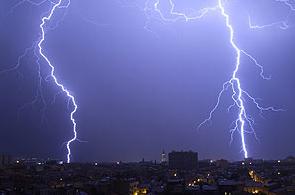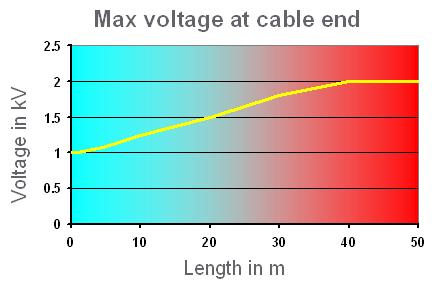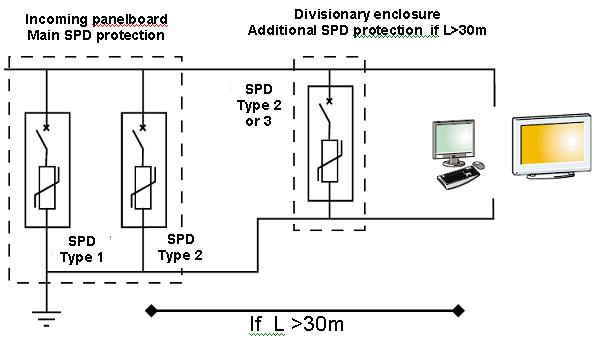Lightning & Surge protection: Advice to ensure a guaranteed lightning protection for a low voltage electrical installation
As everyone knows, the protection against atmospheric over voltages requires installing surge protectors the more upstream (as “main”) as possible of the low voltage electrical installation. This is in order to drive the power of lightning to the ground and avoid it spreading downstream.
But, it is often ignored that such protection is not always sufficient to protect the sensitive electrical equipments, especially when they are away from the upstream surge protector (“main”)
If the length of cable between the “main” surge arrester and the equipment to be protected is too long, oscillations and wave reflections may lead to tensions in the equipment; these tensions can be above the Up level of the same surge protector (until doubled up)
Next figure is : Voltage curve at the end of the cable depending on length of cable (front voltage =4kV/µs)
Why this phenomenon?
Lightning is a phenomenon whose frequency is of the order of hundreds of kHz to MHz. The voltage variations are very fast and we can no longer assume that the voltage is the same at any point of a cable. Oscillations due to the cable own resonant frequencies (parasitic capacitances, filtering) can be excited by the incident surge front
A good image of the phenomenon of total internal reflection is a wave (representing the voltage wave, the height of the wave representing the voltage amplitude) which arrives on a wall: the wave comes crashing against the wall by doubling its height and goes back in the opposite direction.
What is the best solution for a guaranteed lightning protection?
Generally for the voltage surges fronts encountered in a building, the phenomena of reflection are neglected for lengths less than 10m. Beyond 30 m, the risk of doubling the voltage becomes very important
The solution is to add a second surge protector (arrestor) as close as possible to the equipment to be protected
Flow capacity of this second surge device can be reduced (e.g. Imax <8kA (8 / 20)) because the lightning current has already been derived by the main surge protection device (SPD)
Didier Mignardot




very good post
thanks,
plz correct thise “Subsribe to the Newsletter : ” in top of your blog to:”Subscribe to the Newsletter : “
thanks Shahram !
by the way i have difficulties to open your site; could you also check if the link towards our blog is working from your site
dear francois,
plz visited my persian page blog with:http://shahrammoradi.blogfa.com/
and english page:http://eesb.blogfa.com/
your blog added in two above link.
ı think its a very useful method.
hi this is sayed please send me some good and easy calculation for ohms law
hello Sayed,
your question seems too general … is it in relation with this article about surge protection coordination ? please be more specific
Good information. Thanks for sharing. The graphic is a nice illustration and the information about adding a second down-stream protector is most helpful.
I want as u about installation lightning protection. ant install Electrode in to the earth.
i want to know the best materials to use for Surge protection devices for a duplex bulding and the best way of inst it
interesting post my only remark would be that the distance in IEC standards is 10 m and not 30 m
This was very informative i had no idea, this info will surly help me in the future. thanks alot
Surge protection devices is more useful now days, it will protect from the thrunder to keep human safe.
How the scientific method,this is in order to drive the power of lightning to the ground and avoid it spreading downstream.thanks for sharing
Hey! Thanks for a nice post, I like your style:D I’ve bookmarked this page, so if others are interested here is the location of bookmark
You are right. Because of this phenomenal the lightning protection standard IEC 62305 part 4 shows the protection cascades by test class 1 SPD at main entrance board to protect against direct and nearby lightning strokes test wave form 10/350µs, to discharge the main energy (discharge current Iimp) and reduce the voltage to max Up < 4kV (insulation protection) …….a class II SPD with Up < 2,5kV in the subdistribution board (TVSS protection) and last not least an voltage limiting class III SPD near to equipment (as near as possible to the equipment to be protected max 6m ) to limit the supply voltage to < 1,5kV resp. to < 1kV for sensitive equipments.
this says the standard and is a general advise
LEUTRON has a special patented no aging GDT-spark gap SPD…PowerPro BCD …family with a Up of < 1kV at 25kA 10/350µs per pole, which after a distance of 10m between SPD and equipment srill keep the Up value of 10m a voltage limiting SPD with Up < 1kV (at 3-5kA 8/20µs and voltage test 1,2/50µs at Uoc=6kV) of test class III (IEC 61643-11) is sufficient to install at the equipment to protect.
If you staudy the IEC standards and if you understand the background of it, you will not have a problem to plane the best suitable protection system.
but take attention that the UL and ANSI standard take care only to limit voltages (TVSS) but do not take care of the high amount of impulse discharge current form 10/350µs happens at SPD in the main entrance board . MOV SPDs can not discharge such high energy because ot he very high thermal stress of max total 100kA 10/350µs, which can enter via ground in the electric system via the EBB .
Hi,
This is srinivas, thanks for your post.
But I have one query:
If it is a industrial plant or factory it’s ok it is applicable because all of the cable are running outside. So is there lightning strikes the cable it will passed through that.
But how it is applicable to residential and commercial buildings. Incoming service lines we are providing Class B+C SPD, how the internal equipment will get the effect from TVSS.
THANKS HOPE BETTER JOURNEY WITH YOU
[…] between switchbox to the protected equipment) can both lead to voltage increase (not decrease)… http://engineering.electrical-equip…ution/lv-coordination-2-surge-protectors.html "If the length of cable between the “main” surge arrester and the equipment to be […]